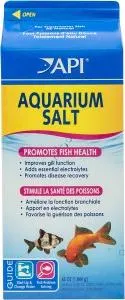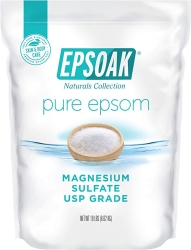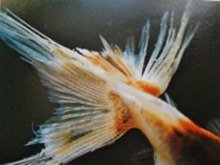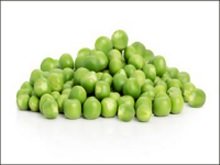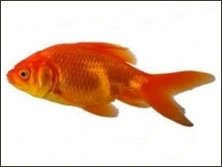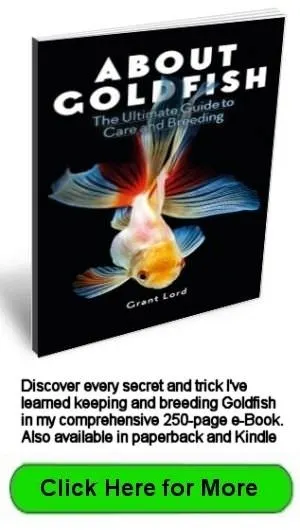- Home
- Disease Causes
- Common Goldfish Diseases
- Goldfish Swim Bladder Disorder
Goldfish Swim Bladder Disorder Treatments
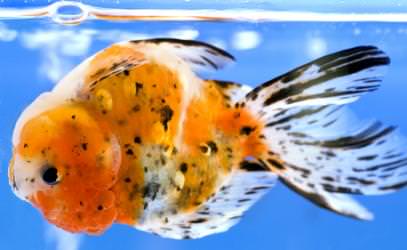 Calico Oranda with a swim bladder disorder
Calico Oranda with a swim bladder disorderIntroduction to Swim Bladder Disorder in Goldfish
The swim bladder (or bladders as there are two) are gas-filled organs that regulate buoyancy and balance.
Small bones at the back of the skull are attached to the front air bladder and are used for hearing and balance.
The larger rear swim bladder has an opening directly into the gut. The fish use this to slightly inflate or deflate the swim bladder, depending on its buoyancy needs. This is why, after a heavy meal, a Goldfish will often go to the surface and take a gulp of air to slightly inflate the swim bladder to maintain close to zero buoyancy.
Swim bladders are normally long sausage-shaped organs. As the body shape of some fancy varieties has become shortened and more rounded, so have their swim bladders. This has made them more susceptible to disorders.
Goldfish Swim bladder disorder, also called swim bladder disease, causes a Goldfish to have buoyancy or balance problems. Although often called a disease, it is most commonly a symptom of something else that has caused the condition, such as poor diet.
Once a Goldfish develops a swim bladder disorder, quick action is required to stop the condition from becoming permanent.
Last Updated: 02-11-2025 by Grant Lord.
Symptoms of Swim Bladder Disorder
The most common symptoms of swim bladder disorder are:
- Floating to the surface, sometimes floating upside down in severe cases
- Sitting on the bottom and struggling to rise
- Swimming on one side
- Swimming head up or head down.
Often, the most common symptom of floating to the surface is not swim bladder related but indigestion, causing a gas buildup in the intestine. In severe cases, the fish loses its ability to control the amount of gas in its swim bladder.
If this happens frequently enough, the fish can lose its ability to maintain neutral buoyancy permanently.
Some fancy varieties, such as Pearl scales, have been developed to such an extent that their bodies resemble golf balls. With such a developed body shape, some individuals tend to swim head down normally, and this shouldn't be confused with the fish having a swim bladder disorder.
Check when the fish stops swimming. It shouldn't have a buoyancy problem, such as floating upwards or sinking. It should be able to remain static in the water without excessive fin movements.
Causes Of Goldfish Swim Bladder Disorders
- Poor quality food. Food that is stale, of poor quality, or unsuitable for Goldfish will cause gas in the gut. If there is enough gas, this alone will cause the fish to lose balance. Some of this gas will often find its way into the swim bladder causing the fish to become too buoyant. The fish can't release the gas if it is constipated.
- Sudden temperature changes. Round-bodied Goldfish are particularly susceptible to chills.
- Infection. A bacterial attack of the swim bladder can cause loss of balance or buoyancy.
- Water conditions. It has been suggested that high nitrate levels in the water can affect the swim bladder as blood vessels around the swim bladders are constricted by high nitrates.
- Swallowing air. Some aquarists only feed sinking pellets to their Goldfish in the belief that floating food causes Goldfish to swallow air. Some fish are predisposed to swallowing air, but in my experience, this is in response to diet.
- Old age/genetics. As fancy varieties age, swim bladder problems become more common. Observing how a fish swims is essential when choosing fish for breeding or culling your brood.
Prevention Strategies
The most common cause of swim bladder disorders is diet. Dry, processed pellets and flakes aren't like the natural diet that is moist, soft, and high in aquatic plants.
Gel foods such as Repashy Super Gold closely copy the natural diet and seldom cause swim bladder disorders.
Other strategies to avoid swim bladder disorders are:
- Keep nitrates below 40 ppm (parts per million).
- Feed green foods frequently. My 11-year-old Black Moor needs to be fed greens immediately after being fed his usual diet of Repashy gel food, otherwise, he will gulp air and start floating to the surface.
- Maintain warmer temperatures, 15oC (60oF) over Winter for fancy varieties, higher if your fish have very deep bodies such as Pearl scales. I keep all my fancies in ponds over Winter, with temperatures dropping to as low as 5oC (40oF), but only for short periods.
- When purchasing or selecting young fish from a spawning, I select individuals who don't swim head down because as these fish age, their swimming often becomes very labored, and they seem more prone to swim bladder disorders.
Treatment Of Swim Bladder Disorder
Initial Treatment Steps
If treatment isn't started soon after a fish is seen distressed, it can lead to permanent imbalance.
Fish that float to the surface will soon develop redness on the belly or dorsal area if the skin is exposed to the air for any length of time.
Swim bladder disorders aren't contagious, but an affected fish needs to be moved to a sick bay to administer the treatments. You also need to observe what waste the fish is passing, which can't be easily seen in a planted aquarium or one with gravel on the bottom.
The water in the sick bay should be fresh, not water from the aquarium or pond as, this may have caused the problem.
Add two teaspoons of Aquarium Salt and the same amount of unscented pure Epsom salts per gallon to the water.
Temperature Management
If the water temperature is very cold, sub 13oC (55oF), warm the water gradually over several days by
8oC
(
15oF).
Aim for a temperature around
20oC
(68oF) or higher.
Often, this is all that is necessary to reverse the symptoms.
Dietary Adjustments
Do not feed the fish for 2-3 days or more. Wait until you see evidence that the fish is passing waste or has regained its balance. If the fish produces excreta that hangs from the anal pore for any length of time and may be light-colored or have gas bubbles interspersed in it, this is a sure sign of indigestion/constipation.
If this treatment fixes the problem after a day or two, feed the fish a small amount of live food. Include some green food such as cooked, shelled peas that have been crushed. I find blanket weed is a readily accepted green food. Make sure this passes through the fish before further feeding.
Slowly increase the amount of food, feeding only live food and greens for at least a week before introducing the fish back into its aquarium or pond. First, test the water pH and nitrate levels and check the food you are using. If there is any doubt about its freshness, throw it out, otherwise the condition will quickly return.
Advanced Treatment Options
If the fish doesn't improve after a few days, different treatments will be required depending on what has occurred over the first few days.
If the fish has passed waste the problem may be bacterial, or the swim bladders may be permanently damaged.
Treat the fish with an antibacterial treatment such as Seachem KanaPlex Fungal & Bacterial Fish Disease medication. The condition may be permanent if this doesn't cure the problem after a few days.
If the fish hasn't passed any waste, don't feed it for a further 2 days, then try to get it to eat blanched peas, baby spinach leaves, or other vegetable matter. Don't feed it any other foods until it has passed what is in the gut because, by now, this food will be fermenting and producing gas.
Long-Term Management and Care
Despite your best efforts, you aren't always going to be successful in treating your Goldfish.
If your fish is floating upwards and is having difficulty swimming normally, this is usually caused by a poor diet. A few days without food and a change in diet will usually remedy the situation.
If your fish lacks buoyancy and sinks to the bottom, this is more serious.
The fish's swim bladders have been damaged by something, and treatment is usually less successful.
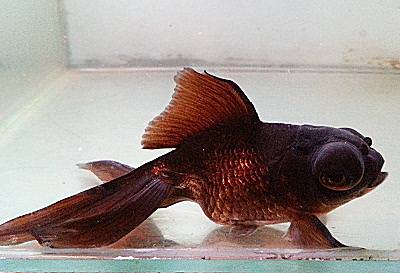 Black Moor with a permanent swim bladder disorder
Black Moor with a permanent swim bladder disorderIf the fish doesn't respond to treatments after several weeks, you can assume the condition is permanent.
A fish that keeps floating to the surface will start to develop redness on areas exposed to the air when the fish rests.
Depending on the severity, ongoing treatment entails adding four teaspoons of Aquarium salt per gallon and two teaspoons of API Stress Coat per 10 gallons of water. This will help protect the skin against infection.
Feeding is a problem with a floater. If the fish can swim upright periodically, it can be fed live foods that swim in the water column, such as daphnia.
Feed foods that float as sinking foods will be too hard for the fish to swim down to, especially if the aquarium is tall.
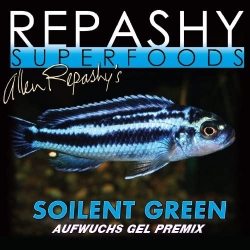
If the fish is bouncing like a cork, making feeding impossible, hand feeding is your only option. The easiest method is to feed a gel food such as Repashy Soilent Green or Repashy Super Gold.
A fish that sinks to the bottom has a better chance of survival.
Over time, the weight of the fish tends to crush the soft belly area, and the ventral fins can be worn away from constant rubbing against the bottom as seen in the Black Moor image above.
Having no gravel in the aquarium is better so the fish can slide around the bottom more easily, find food, and avoid redness developing on the ventral area.
These fish often make trips to the surface in an attempt to re-inflate their air bladder, so keep the water level at no more than 300mm (12 inches) deep.
Ongoing treatment is the same, but the salt can be reduced to two teaspoons per gallon. Increase the salt level if redness develops on the fins or belly area.
Feeding a fish that sinks is easier. The food needs to sink. Live foods that sink to the bottom, such as tubifex worms, are ideal. Repashy Soilent Green gel food sinks and doesn't rapidly dissolve as most pellet foods do.
Conclusion
Early detection and treatment are vital to prevent permanent damage.
Once a fish has had a swim bladder disorder, it becomes more susceptible to the complaint recurring.
It is vital that green and live foods form a large part of the diet of fancy varieties because the most common causes of this disorder are poor quality food and a lack of live food.
Low water temperatures often bring on a swim bladder disorder because Goldfish process food differently at those temperatures. Feed lightly with foods high in green matter and low in protein.
Top of Goldfish Swim Bladder Disorder page

